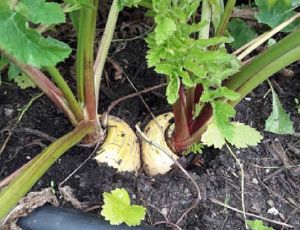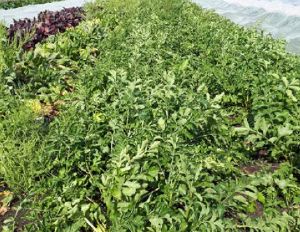Parsnip

Growing parsnips is very similar to growing that of the carrot. In particular, sowing is just as as the carrot. Parsnips are not a main crop, but it can be used to diversify winter root vegetables.
Preparing the soil
For parsnips, it's important to have very clean soil, because weeding will rehabilitate the crop. Like for carrots, a smothering crop or one grown on a tarpaulin (e.g. : squash, lettuce) preceding that of parsnips is beneficial. The seedbed is prepared by spreading 3 to 10 cm of compost or fine shredding to prevent weed growth and encourage soil-seed contact. The pieces of wood in the compost must be removed so that the seed drill does not "jam".
Chaff can be used instead of compost or shredded material.
then sow and cover with chaff. It retains
and reduces watering, especially if there is compost underneath.
compost underneath. Avoid heavy, shallow
poorly structured and/or stony soils to ensure an attractive
elongated shape.

Planting
As with carrots, it is important to have a very clean, fine seedbed fineseedbed to ensure goodseed/compost contact. seed/compost contact. Seed is sown using a drill, adjusting the settings according to the expected density to avoid to avoid the need to remove the seed. Rolling the seed over the compost on the compost can encourage germination.
Tip : Small parsnips can be harvested in bunches, which serves to thin them out. Pre-sprouted seeds are available.
Crop monitoring

In the event of a capricious and long emergence, weed at the start of the crop (weeder in the inter-row and manually in the row).
row). Carry out localised thermal weeding in the days after sowing is possible, to be carried out just before the parsnips emerge. just before the parsnips emerge ! Take care with sowing density to avoid thinning, which will guarantee parsnip size.
When the crop reaches a height of 5 to 10 cm, mulch by hand
between rows to smother and prevent the germination
of new weeds. For conservation parsnips
(no bunches), as long as the parsnip tops remain above the
weed cover can be tolerated at the end of the crop.
of the crop. Beware, however, of the risk of certain weeds
of certain weeds.
Irrigation
Irrigation is much the same as for carrots. keep the soil cool during emergence, irrigate regularly as the roots regular irrigation as the roots grow. Count on 1 to 2 waterings a week, depending on the weather type of soil, so keep an eye on the watering frequency The frequency of watering will determine the size at harvest.
Harvest
Parsnips can be harvested when the roots are 5 to 8 cm in diameter. Harvesting is done by hand, with prior irrigation and a spading fork are used to loosen the soil so that the roots can be removed more easily.
Storage
Like other root vegetables, parsnips can be stored in the :
- In the field in draining / sandy soil (even though parsnips are less gelling than carrots, beware of extreme cold, which can cause them to wilt, and of field mice and other pests).
- In sand trays.
- In cellars in paloxes/crates.
- In in-ground or above-ground silos (in nets or micro-perforated bags of compost).
- In a cold room, storage temperature :
- Ideally 2°C, otherwise 10 to 15°C.
- Relative humidity 90 / 95 %.
Pests and diseases
Pests are the same as for carrots :
- The biggest problem is the carrot fly, which is rife between May and November. Appropriate protective netting provides good protection. Crop rotation is also a useful tool, as is the choice of more resistant varieties.
- Finally, watch out for slugs at the seedling stage, which can wipe out an entire sowing. For slug management, see the slug sheet.
Possible ITK variations
Parsnips can also be sown on bare soil with very shallow tillage and without compost. However, the risk of weed emergence is greater. One or two one or two false sowings, using a thermal weeder or tarpaulin using tarpaulins, will limit weed infestation.
Sources
- This page is based on the guide Introduction au maraîchage sol vivant from MSV Normandie.
